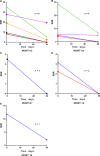MGMT autoantibodies as a potential prediction of recurrence and treatment response biomarker for glioma patients
- PMID: 31210005
- PMCID: PMC6675704
- DOI: 10.1002/cam4.2346
MGMT autoantibodies as a potential prediction of recurrence and treatment response biomarker for glioma patients
Abstract
Background: Cancer-specific autoantibodies found in serum of cancer patients have been characterized as potential predictors of the high risk of recurrence and treatment response. The objective of this study is to investigate the clinical utility of serum O-6-methylguanine-DNA methyltransferase (MGMT) autoantibodies as novel biomarkers for prediction of recurrence and treatment response for glioma through MGMT peptides microarray.
Methods: A total of 201 serum samples of glioma patients with various WHO grade and 311 serum samples of healthy donors were examined for the detection of MGMT autoantibodies by peptides microarray. The clinical value of MGMT autoantibodies was studied through univariable and multivariable analyses.
Results: Autoantibodies to MGMT peptides were detected in sera from glioma patients and five highly responsive autoantibodies to peptides were identified in the glioma group. The positive rate of MGMT autoantibody to 20 peptides in glioma groups is compared with healthy individuals, the positive rate of MGMT-02 (45%), MGMT-04 (27%), MGMT-07 (21%), MGMT-10 (13%), and MGMT-18 (24%) were significantly elevated in patients with glioma. MGMT autoantibody and its protein expression exhibited a significant correlation. The levels of MGMT autoantibodies decreased on the 30th day after operation, reaching preoperative levels, similar to those when tumor recurrence developed. Univariable and multivariable analyses revealed that the only preoperative autoantibodies to MGMT-02 peptide were independently correlated with recurrence-free survival. Preoperative seropositive patients were more likely than seronegative patients to have shorter recurrence times and to be resistant to chemoradiotherapy or chemotherapy with temozolomide.
Conclusion: Monitoring the levels of preoperative serum autoantibodies to MGMT-02 peptide was useful for predicting patients at high risk of recurrence and treatment response.
Keywords: MGMT; autoantibodies; prediction of recurrence; treatment response.
© 2019 The Authors. Cancer Medicine published by John Wiley & Sons Ltd.
Conflict of interest statement
No potential conflict of interest was disclosed.
Figures






Similar articles
-
Identification of MGMT promoter methylation sites correlating with gene expression and IDH1 mutation in gliomas.Tumour Biol. 2016 Oct;37(10):13571-13579. doi: 10.1007/s13277-016-5153-4. Epub 2016 Jul 28. Tumour Biol. 2016. PMID: 27468718
-
Expression of glioma stem cell marker CD133 and O6-methylguanine-DNA methyltransferase is associated with resistance to radiotherapy in gliomas.Oncol Rep. 2011 Nov;26(5):1305-13. doi: 10.3892/or.2011.1393. Epub 2011 Jul 18. Oncol Rep. 2011. PMID: 21769436
-
MGMT promoter methylation determined by HRM in comparison to MSP and pyrosequencing for predicting high-grade glioma response.Clin Epigenetics. 2016 May 5;8:49. doi: 10.1186/s13148-016-0204-7. eCollection 2016. Clin Epigenetics. 2016. PMID: 27158275 Free PMC article.
-
Clinicopathological factors predictive of postoperative seizures in patients with gliomas.Seizure. 2016 Feb;35:93-9. doi: 10.1016/j.seizure.2015.12.013. Epub 2015 Dec 31. Seizure. 2016. PMID: 26808114
-
Regulation of expression of O6-methylguanine-DNA methyltransferase and the treatment of glioblastoma (Review).Int J Oncol. 2015 Aug;47(2):417-28. doi: 10.3892/ijo.2015.3026. Epub 2015 May 29. Int J Oncol. 2015. PMID: 26035292 Free PMC article. Review.
Cited by
-
Anti-Cancer Auto-Antibodies: Roles, Applications and Open Issues.Cancers (Basel). 2021 Feb 15;13(4):813. doi: 10.3390/cancers13040813. Cancers (Basel). 2021. PMID: 33672007 Free PMC article. Review.
-
The Versatile Attributes of MGMT: Its Repair Mechanism, Crosstalk with Other DNA Repair Pathways, and Its Role in Cancer.Cancers (Basel). 2024 Jan 11;16(2):331. doi: 10.3390/cancers16020331. Cancers (Basel). 2024. PMID: 38254819 Free PMC article. Review.
-
Blood Biomarkers of Glioma in Response Assessment Including Pseudoprogression and Other Treatment Effects: A Systematic Review.Front Oncol. 2020 Aug 14;10:1191. doi: 10.3389/fonc.2020.01191. eCollection 2020. Front Oncol. 2020. PMID: 32923382 Free PMC article.
-
Experimental study of selective MGMT peptides mimicking TMZ drug resistance in glioma.Biochem Biophys Rep. 2022 Nov 14;32:101386. doi: 10.1016/j.bbrep.2022.101386. eCollection 2022 Dec. Biochem Biophys Rep. 2022. PMID: 36407484 Free PMC article.
-
MGMT promoter methylation status shows no effect on [18F]FET uptake and CBF in gliomas: a stereotactic image-based histological validation study.Eur Radiol. 2022 Aug;32(8):5577-5587. doi: 10.1007/s00330-022-08606-9. Epub 2022 Feb 22. Eur Radiol. 2022. PMID: 35192012
References
-
- Omuro A, DeAngelis LM. Glioblastoma and other malignant gliomas: a clinical review. JAMA. 2013;310:1842‐1850. - PubMed
-
- Christmann M, Verbeek B, Roos WP, Kaina B. O(6)‐methylguanine‐DNA methyltransferase (MGMT) in normal tissues and tumors: enzyme activity, promoter methylation and immunohistochemistry. Biochem Biophys Acta. 2011;1816:179‐190. - PubMed
-
- Kaina B, Christmann M, Naumann S, Roos WP. MGMT: key node in the battle against genotoxicity, carcinogenicity and apoptosis induced by alkylating agents. DNA Repair. 2007;6:1079‐1099. - PubMed
Publication types
MeSH terms
Substances
LinkOut - more resources
Full Text Sources
Medical
Research Materials

